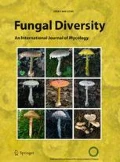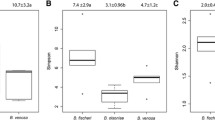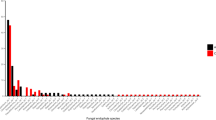Abstract
Fungal research on non-lichenized taxa in xeric and other unusual habitats for fungi is comparatively scarce but constantly reveal an enormous ecological and functional adaptiveness of these organisms to extremes. This holds true in the topmost forest canopies as well as in marine, arctic, antarctic or desert habitats. In the present study dried leaves of Populus euphratica from a continental desert area in Central China were investigated for endophytic fungi 6 weeks after sampling by cultivation of small leaf fragments. Thirty-five species, many of them well-known from extreme environments, were delimitated from as few as 58 isolates by a combined analysis of morphotypes, micromorphology and ITS sequences. Meta-analyses revealed pronounced conspecificity to endophytes from Populus tremula leaves, but significant differences to foliar endophytic assemblages in Pinus monticola and Fagus sylvatica. The deduced high similarity of endophytic communities on both Populus species compared with that on Pinus and Fagus suggests that many fungal phyllosphere species show a well-pronounced host preference, at least for their endophytic stages. In addition, it demonstrates that leaving leaves as a microhabitat might provide similar conditions such as constantly high relative humidity, regardless of the surrounding climatic conditions. The evolution of extremotolerance might be of particular importance for retaining competitiveness of foliar endophytes in deciduous host trees after loss of pathogenicity.




Similar content being viewed by others
References
Abarenkov K, Nilsson RH, Larsson K-H et al (2010) The UNITE database for molecular identification of fungi–recent updates and future perspectives. New Phytol 186:281–285
Albrectsen BR, Björkén L, Varad A et al (2010) Endophytic fungi in European aspen (Populus tremula), detection, and a suggested correlation of herbivory resistance. Fungal Divers 41:17–28
Bayman P (2006) Diversity, scale and variation of endophytic fungi in leaves of tropical plants. In: Bailey MJ, Lilley AK, Timms-Wilson TM, Spencer-Phillips PTN (eds) Microbial ecology of aerial plant surfaces. CABI International, Cambridge, pp 37–50
Bensch K, Groenewald JZ, Dijksterhuis J, et al. (2010) Species and ecological diversity within the Cladosporium cladosporioides complex (Davidiellaceae, Capnodiales). Stud Mycol 1–94
Bewley JD (1979) Physiological aspects of desiccation tolerance. Ann Rev Plant Physiol 30:195–238
Bills GF (1996) Isolation and analysis of endophytic fungal communities from woody plants. In: Redlin SC, Carris LM (eds) Endophytic fungi in grasses and woody plants, systematics, ecology and evolution. American Phytopathological Society Press, St. Paul, pp 31–65
Bitzer J, Thomas L, Fournier J et al (2008) Affinities of Phylaciaand the daldinoid Xylariaceae, inferred from chemotypes of cultures and ribosomal DNA sequences. Mycol Res 112:251–270
Botella L, Julio Javier D (2011) Phylogenic diversity of fungal endophytes in Spanish stands of Pinus halepensis. Fungal Divers 47:9–18
Browicz K (1977) Chorology of Populus euphratica Olivier. Arboretum Kórnickie 22:5–27
Butin H (1992) Effect of endophytic fungi from oak (Quercus robur L.) on the mortality of leaf inhabiting gall insects. J Forest Pathol 22:237–246
Camara MPS, Palm ME, van Berkum P, O'Neill NR (2002) Molecular phylogeny of Leptosphaeria and Phaeosphaeria. Mycologia 94:630–640
Carroll G (1988) Fungal endophytes in stems and leaves: from latent pathogen to mutualistic symbiont. Ecology 69:2–9
Carroll G (1995) Forest endophytes–patterns and process. Can J Bot 73(suppl 1 E–H):S1316–S1324
Crous PW, Summerell BA, Shivas RG et al (2011) Fungal Planet description sheets: 92–106. Persoonia 27:130–162
de Hoog S, Zalar P, van den Ende BG, Gunde-Cimerman N (2005) Relation of halotolerance to human-pathogenicity in the fungal tree of life: an overview of ecology and evolution under stress. In: Gunde-Cimerman N, Oren A, Plemenitas A (eds) Adaptation to life at high salt concentrations in Archaea, Bacteria and Eukarya, 1–25
Fisher PJ, Sutton BC, Petrini LE, Petrini O (1994) Fungal endophytes from Opuntia stricta: a first report. Nova Hedw 59:195–200
Freeman S, Rodriguez RJ (1993) Genetic conversion of a fungal plant pathogen to a nonpathogenic, endophytic mutualist. Science 260:75–78
Fröhlich-Nowoisky J, Pickersgill DA, Després VR, Pöschl U (2009) Diversity of fungi in air particulate matter. PNAS 106:12814–12819
Gange AC (1996) Positive effects of endophyte infection on sycamore aphids. Oikos 75:500–510
Ganley RJ, Newcombe G (2006) Fungal endophytes in seeds and needles of Pinus monticola. Mycol Res 110:318–327
Gilbert GS, Reynolds DR, Bethancourt A (2007) The patchiness of epifoliar fungi in tropical forests: host range, host abundance, and environment. Ecology 88:575–581
Gock MA, Hocking AD, Pitt JI, Poulos PG (2003) Influence of temperature, water activity and pH on growth of some xerophilic fungi. J Food Microbiol 2481:11–19
González V, Tello ML (2011) The endophytic mycota associated with Vitis vinifera in central Spain. Fungal Divers 47:29–42
Gostincar C, Grube M, de Hoog S, Zalar P, Gunde-Cimerman N (2010) Extremotolerance in fungi: evolution on the edge. FEMS Microbiol Ecol 71:2–11
Gries D, Foetzki A, Arndt SK et al (2005) Production of perennial vegetation in an oasis-desert transition zone in NW China–allometric estimation and assessment of flooding and use effects. Plant Ecol 181:23–43
Hartmann M, Lee S, Hallam SJ, Mohn WW (2009) Bacterial, archaeal and eukaryal community structures throughout soil horizons of harvested and naturally disturbed forest stands. Environ Microbiol 11:3045–3062
Higgins KL, Arnold AE, Miadlikowska J, Sarvate SD, Lutzoni F (2007) Phylogenetic relationships, host affinity, and geographic structure of boreal and arctic endophytes from three major plant lineages. Mol Phylogenet Evol 42:543–555
Hoffman MT, Arnold AE (2010) Diverse bacteria inhabit living hyphae of phylogenetically diverse fungal endophytes. Appl Environ Microbiol 76:4063–4075
Houbraken J, Frisvad JC, Samson RA (2011) Taxonomy of Penicillium section Citrina. Stud Mycol 70:53–137
Huelsenbeck JP, Ronquist RR (2001) MrBayes: Bayesian inference of phylogeny. 17: 754–755
Huhndorf SM, Glawe DA (1990) Pycnidial development from ascospores of Fenestella princeps. 82: 541–548
Hyde KD, Soytong K (2008) The fungal endophyte dilemma. Fungal Divers 33:163–173
Jumpponen A, Jones KL (2009) Massively parallel 454 sequencing indicates hyperdiverse fungal communities in temperate Quercus macrocarpa. New Phytol 184:438–448
Kirk PM, Cannon PF, Minter DW, Stalpers JA (2008) Ainsworth & Brisby’s dictionary of the fungi. CABI Publishing, UK
Ko Ko T, Stephenson SL, Bahkali AH, Hyde KD (2011) From morphology to molecular biology: can we use sequence data to identify fungal endophytes? Fungal Divers 50:113–120
Kumar S, Filipski A (2007) Sequence alignment: in pursuit of homologous DNA positions. Genome Res 17:127–135
Li H-Y, Shen M, Zhou Z-P et al (2012) Diversity and cold adaptation of endophytic fungi from five dominant plant species collected from the Baima Snow Mountain, Southwest China. Fungal Divers. doi:10.1007/s13225-012-0153-1
Liu MG (1997) Zhongguo ziran dili tuce (Atlas of nature and geography of China; in Chinese). Zhongguo Tuce Chubanshe (China Cartographic Press), Beijing
Lodge DJ, Fisher PJ, Sutton BC (1996) Endophytic fungi of Manilkara bidentata in Puerto Rico. Mycologia 88:733–738
Maddison WP, Maddison DR (2011) Mesquite: a modular system for evolutionary analysis. Version 2.75 http://mesquiteproject.org, assessed 20/02/2012
Martinez-Culebras PV, Abad-Campos P, Garcia-Jimenez J (2004) Molecular characterization and PCR detection of the melon pathogen Acremonium cucurbitacearum. Eur J Plant Pathol 110:801–809
Mayr S, Hacke U, Schmid P, et al. (2006) Frost drought in conifers at the alpine timberline: xylem dysfunction and adaptations. 87: 3175–3185
McCune B, Mefford MJ (2006) PC-ORD. Multivariate analysis of ecological data. Version 5. MjM Software, Gleneden Beach, Oregon, U.S.A. MjM Software, Gleneden Beach, Oregon, U.S.A.
Menkis A, Allmer J, Vasiliauskas R, Lygis V, Stenlid J, Finlay R (2004) Ecology and molecular characterization of dark septate fungi from roots, living stems, coarse and fine woody debris. Mycol Res 108:965–973
Nagy LG, Hazi J, Vagvoelgyi C, Papp T (2012) Phylogeny and species delimitation in the genus Coprinelluswith special emphasis on the haired species. Mycologia 104:254–275
Nilsson RH, Veldre V, Hartmann M et al (2010) An open source software package for automated extraction of ITS1 and ITS2 from fungal ITS sequences for use in high-throughput community assays and molecular ecology. Fungal Ecol 3:284–287
Nylander JAA (2004) MrModeltest [computer program]. Version 2.1. Uppsala: Evolutionary Biology Centre, Uppsala University, by the author
Onofri S, Selbmann L, Zucconi L, Pagano S (2004) Antarctic microfungi as models for exobiology. Planet Space Sci 52:229–237
Ottow EA, Polle A, Brosché M, et al. (2005) Molecular characterization of PeNhaD1: the first member of the NhaD Na+/H+ antiporter family of plant origin. Plant Mol Biol: 73–86
Paulus B, Gadek P, Hyde KD (2003) Estimation of microfungal diversity in tropical rainforest leaf litter using particle filtration: the effects of leaf storage and surface treatment. Mycol Res 107:748–756
Peterson SW (2011) Phylogeny and nomenclature of the genus Talaromyces and taxa accommodated in Penicillium subgenus Biverticillium. Stud Mycol 70:159–183
Petrini O (1991) Fungal endophytes of tree leaves. In: Andrews JH, Hirano SS (eds) Microbiology of the phyllosphere. Cambridge University Press, Cambridge, pp 175–187
Petrini O, Sieber TN, Toti L, Viret O (1992) Ecology, metabolite production, and substrate utilization in endophytic fungi. Nat Toxins 1:185–196
Pirttilä AM, Frank AC (2011) Endophytes of forest trees–biology and applications. Forestry Sciences 80. Springer, Berlin
Pitt JI (1975) Xerophilic fungi and the spoilage of foods of plant origin. In: Duckworth RB (ed) Water relations of foods. Academic, London, pp 273–307
Polizzotto R, Andersen B, Martini M, Grisan S, Assante G, Musetti R (2012) A polyphasic approach for the characterization of endophytic Alternaria strains isolated from grapevines. J Microbiol Methods 88:162–171
Promputtha I, Hyde KD, McKenzie EHC, Pederby JF, Lumyong S (2010) Can leaf degrading enzymes provide evidence endophytic fungi becoming saprobes? Fungal Divers 41:89–99
Rocha ACS, Garcia D, Uetanabaro APT et al (2011) Foliar endophytic fungi from Hevea brasiliensis and their antagonism on Microcyclus ulei. Fungal Divers 47:75–84
Rodrigues A, Mueller UG, Ishak HD, Bacci M Jr, Pagnocca FC (2011) Ecology of microfungal communities in gardens of fungus-growing ants (Hymenoptera: Formicidae): a year-long survey of three species of attine ants in Central Texas. FEMS Microbiol Ecol 78:244–255
Rodriquez RJ, White JF, Arnold AE, Redman RS (2009) Fungal endophytes: diversity and functional roles. New Phytol 182:314–330
Saikkonen K, Faith SH, Helander M, Sullivan TJ (1998) Fungal endophytes: a continuum of interactions with host plants. Annu Rev Ecol Syst 29:319–343
Santamaría J, Bayman P (2005) Fungal epiphytes and endophytes of coffee leaves (Coffea arabica). Ecol 50:1–8
Schnittler M, Eusemann P (2010) Consequences of genotyping errors for estimation clonality: a case study on Populus euphratica (Salicaceae). Evol Ecol 24:1417–1432
Schubert K, Groenewald JZ, Braun U et al (2007) Biodiversity in the Cladosporium herbarum complex (Davidiellaceae, Capnodiales), with standardisation of methods for Cladosporium taxonomy and diagnostics. Stud Mycol 58:105–156
Schulz B, Boyle C (2005) The endophytic continuum. Mycol Res 109:661–686
Scott JA, Wong B, Summerbell RC, Untereiner WA (2008) A survey of Penicillium brevicompactum and P. Bialowiezense from indoor environments, with commentary on the taxonomy of the P. Brevicompactum group. Botany 86:732–741
Selbmann L, de Hoog GS, Mazzaglia A, Friedmann EI, Onofri S (2005) Fungi at the edge of life: cryptoendolithic black fungi from Antarctic desert. Stud Mycol 51:1–32
Sherwood MA (1981) Convergent evolution in discomycetes from bark and wood. Bot J Linn Soc 82:15–34
Spatafora JW, Sung GH, Hywel-Jones NL, White JF (2007) Phylogenetic evidence for an animal pathogen origin of ergot and the grass endophytes. Mol Ecol 16:1701–1711
Stone JK, Sherwood MA, Carroll GC (1996) Canopy microfungi: function and diversity. Northwest Science Spec (70): 37–45
Strobel GA (2003) Endophytes as sources of bioactive products. Microbes Inf 5:534–544
Sun Y, Wang Q, Lu X, Okane I, Kakishima M (2011) Endophytic fungal community in stems and leaves of plants from desert areas in China. Mycol Progr. doi:10.1007/s11557-011-0790-x
Suryanarayanan TS (2011) Diversity of fungal endophytes in tropical trees. In: Pirttilä AM, Frank AC (eds) Endophytes of forest trees–biology and applications. Forestry Sciences 80. Springer, Berlin, pp 67–80
Suryanarayanan TS, Wittlinger SK, Faeth SH (2005) Endophytic fungi with cacti in Arizona. Mycol Res 109:635–639
Thevs N, Zerbe S, Schnittler M, Abdusalih N, Succow M (2008) Structure, reproduction, and flood-induced dynamics of riparian Tugai forests at the Tarim River in Xinjiang, NW China. Forestry 45–57
Thomas FM, Foetzki A, Arndt SK et al (2006) Water use by perennial plants in the transition zone between river oasis and desert in NW China. Basic Appl Ecol 7:253–267
Tian YZ (1991) Tokai on the delta at the lower reach of Keriya River—a natural vegetation complex reflecting ecological degradation. In: Jäkel D (ed) Reports on the “1986 Sino-German Kunlun-shan expedition”, für Erdkunde zu Berlin, Berlin, pp. 99–112
Todd D (1988) The effects of host genotype, growth-rate, and needle age on the distribution of a mutualistic, endophytic fungus in Douglas-fir plantations. Can J Forest Res 18:601–605
Unterseher M, Schnittler M (2009) Dilution-to-extinction cultivation of leaf-inhabiting fungi in beech (Fagus sylvatica.)–different techniques influence fungal biodiversity. Mycol Res 113:645–654
Unterseher M, Schnittler M (2010) Species richness analysis and ITS rDNA phylogeny revealed majority of cultivable foliar endophytes from beech (Fagus sylvatica). Fungal Ecol 3:366–378
Unterseher M, Tal O (2006) Influence of small scale conditions on the diversity of wood decay fungi in a temperate, mixed deciduous forest canopy. Mycol Res 110:169–178
Vega FE, Goettel MS, Blackwell M et al (2009) Fungal entomopathogens: new insights on their ecology. Fungal Ecol 2:149–159
Wang S, Chen B, Li H (1996) Euphrates poplar forest. China Environmental Science Press, Beijing
Weber RWS, Anke H (2006) Effects of endophytes on colonisation by leaf surface microbiota. In: Bailey MJ, Lilley AK, Timms-Wilson TM, Spencer-Phillips PTN (eds) Microbial ecology of aerial plant surfaces. CABI International, Cambridge, pp 209–222
Weiß M, Sykorova Z, Garnica S et al (2011) Sebacinales everywhere: previously overlooked ubiquituous fungal endophytes. PLoS One 6:e16793
Wiehle M, Eusemann P, Thevs N, Schnittler M (2009) Root suckering patterns in Populus euphratica (Euphrates poplar, Salicaceae). Trees 23:991–1001
Wilson D (1995) Endophyte—the evolution of a term, and clarification of its use and definition. Oikos 73:274–276
Zhang HW, Song YC, Tan RX (2006) Biology and chemistry of endophytes. Nat Prod Rep 23:753–771
Acknowledgments
The authors thank their University and the “Akademisches Auslandsamt Greifswald” for funding within the “Forschungsnetzwerk Ostseeraum 2011”. MU thanks Urmas Kõljalg, Leho Tedersoo and Kessy Abarenkov for introduction into UNITE and PlutoF, AP and MS thank the German Science Foundation (DFG) for funding (DFG SCHN 1080/1-1 and SCHN 1080/3-1).
Author information
Authors and Affiliations
Corresponding author
Electronic supplementary material
Below is the link to the electronic supplementary material.
Supplementary Table 1
Species list of leaf-inhabiting fungal endophytes of Populus euphratica and their GenBank accession numbers. The best fully annotated sequences from BLAST are displayed; literature comments are provided to trace the reliability of BLAST searches. (XLS 17 kb)
Rights and permissions
About this article
Cite this article
Unterseher, M., Petzold, A. & Schnittler, M. Xerotolerant foliar endophytic fungi of Populus euphratica from the Tarim River basin, Central China are conspecific to endophytic ITS phylotypes of Populus tremula from temperate Europe. Fungal Diversity 54, 133–142 (2012). https://doi.org/10.1007/s13225-012-0167-8
Received:
Accepted:
Published:
Issue Date:
DOI: https://doi.org/10.1007/s13225-012-0167-8




